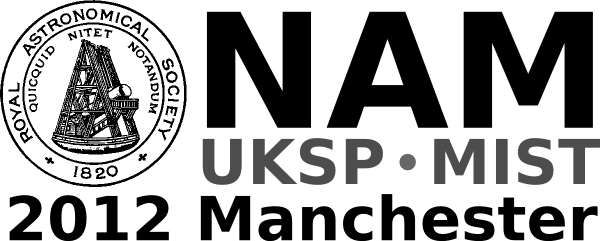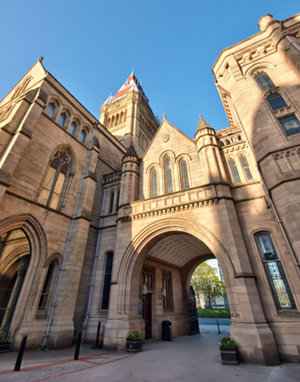UK-Germany National Astronomy Meeting NAM2012
Brand new European Astronomy Journalism Prize launches at NAM
Royal Astronomical Society press release (forwarded from STFC)
RAS PR 12/31, NAM 22
29 March 2012
A new journalism competition to capture and promote inspirational coverage of astronomy will be launched on Thursday 29 March at the National Astronomy Meeting in Manchester. The prize is the ultimate for any astronomy enthusiast - a trip to the European Southern Observatory's (ESO) Very Large Telescope in Chile.
Never a week goes by without coming across stories or features on astronomy in the UK media; yet many of the people behind the stories have never had the opportunity to visit the facilities that produce the results they are covering. The Very Large Telescope is the world's most advanced optical instrument, and is located at the Paranal Observatory on Cerro Paranal, a 2,635m mountain in the northern part of Chile.
Entries into the European Astronomy Journalism Prize must be about astronomy and related areas of technology, or about the work and lifestyles or astronomers, engineers or others working in the field of astronomy. Online, written or broadcast entries are welcome.
The competition is being run by the Science and Technology Facilities Council (STFC) and European Southern Observatory (ESO, in conjunction with the Association of British Science Writers and the Royal Astronomical Society. It is open for entries from Monday 2 April 2012 until Friday 27 July 2012. Works must have appeared in English and in the UK, between 1 July 2011 and 30 June 2012 inclusive to be eligible. They must reflect European interests.
A full list of terms and conditions can be found at www.stfc.ac.uk/astroprize and at www.eso.org/public/astroprize/
IMAGE
An image of the prize winner's destination in Chile can be found alongside other images of the Very Large Telescope and Paranal on ESO's website: http://www.eso.org/public/images/archive/category/paranal/
MEDIA CONTACTS
Lucy Stone
Press Office
STFC Rutherford Appleton Laboratory
Tel: +44 (0)1235 445 627
Mob: +44 (0)7920 870125
Email: lucy.stone@stfc.ac.uk
Oana Sandu
Education and Public Outreach
ESO
Tel: +49 89 320 069 65
Email: osandu@eso.org
NAM 2012 Press Office (0900 - 1730 BST, 27-29 March; 0900 - 1630 BST 30 March)
Room 3.214
University Place building
University of Manchester
Manchester
UK
Tel: +44 (0)161 306 7313
Dr Robert Massey
Royal Astronomical Society
Mob: +44 (0)794 124 8035
Email: rm@ras.org.uk
Anita Heward
Royal Astronomical Society
Mob: +44 (0)7756 034 243
Email: anitaheward@btinternet.com
Dr Klaus Jaeger
Pressereferent / Press Officer im Vorstand der Astronomischen Gesellschaft
Tel: +49 6221 528 379
Email: pressereferent@astronomische-gesellschaft.de
Dan Cochlin
Media Officer (Faculty of Engineering and Physical Sciences)
University of Manchester
Tel: +44 (0)161 275 8387
Email: daniel.cochlin@manchester.ac.uk
NOTES FOR EDITORS
Full details about the competition including a full set of terms and conditions that must be adhered to by those entering can be found at www.stfc.ac.uk/astroprize
Science and Technology Facilities Council
The Science and Technology Facilities Council (STFC: www.stfc.ac.uk) is keeping the UK at the forefront of international science and tackling some of the most significant challenges facing society such as meeting our future energy needs, monitoring and understanding climate change, and global security.
The Council has a broad science portfolio and works with the academic and industrial communities to share its expertise in materials science, space and ground-based astronomy technologies, laser science, microelectronics, wafer scale manufacturing, particle and nuclear physics, alternative energy production, radio communications and radar.
STFC operates or hosts world class experimental facilities including:
in the UK; ISIS pulsed neutron source, the Central Laser Facility, and LOFAR. STFC is also the majority shareholder in Diamond Light Source Ltd.
overseas; telescopes on La Palma and Hawaii
It enables UK researchers to access leading international science facilities by funding membership of international bodies including European Laboratory for Particle Physics (CERN), the Institut Laue Langevin (ILL), European Synchrotron Radiation Facility (ESRF) and the European Southern Observatory (ESO).
STFC also has an extensive public outreach and engagement programme. It is using its world leading research to inspire and enthuse schools and the general public about the impact and benefits that science can have on society.
STFC is one of seven publicly-funded research councils. It is an independent, non-departmental public body of the Department for Business, Innovation and Skills (BIS).
Follow us on Twitter @STFC_Matters
European Southern Observatory
The year 2012 marks the 50th anniversary of the founding of the European Southern Observatory (ESO). ESO is the foremost intergovernmental astronomy organisation in Europe and the world's most productive astronomical observatory. It is supported by 15 countries: Austria, Belgium, Brazil, the Czech Republic, Denmark, France, Finland, Germany, Italy, the Netherlands, Portugal, Spain, Sweden, Switzerland and the United Kingdom. ESO carries out an ambitious programme focused on the design, construction and operation of powerful ground-based observing facilities enabling astronomers to make important scientific discoveries. ESO also plays a leading role in promoting and organising cooperation in astronomical research. ESO operates three unique world-class observing sites in Chile: La Silla, Paranal and Chajnantor. At Paranal, ESO operates the Very Large Telescope, the world's most advanced visible-light astronomical observatory and two survey telescopes. VISTA works in the infrared and is the world's largest survey telescope and the VLT Survey Telescope is the largest telescope designed to exclusively survey the skies in visible light. ESO is the European partner of a revolutionary astronomical telescope ALMA, the largest astronomical project in existence. ESO is currently planning a 40-metre-class European Extremely Large optical/near-infrared Telescope, the E-ELT, which will become "the world's biggest eye on the sky". http://www.eso.org/public
NAM 2012
Bringing together more than 900 astronomers and space scientists, the National Astronomy Meeting (NAM 2012) will take place from 27-30 March 2012 in the University Place conference centre at the University of Manchester in the UK. The conference is a joint meeting of the Royal Astronomical Society (RAS) and the German Astronomische Gesellschaft (AG) and is held in conjunction with the UK Solar Physics (UKSP: www.uksolphys.org) and Magnetosphere Ionosphere Solar Terrestrial (MIST: www.mist.ac.uk) meetings. NAM 2012 is principally sponsored by the RAS, AG, STFC and the University of Manchester.
The Royal Astronomical Society
The Royal Astronomical Society (RAS: www.ras.org.uk), founded in 1820, encourages and promotes the study of astronomy, solar-system science, geophysics and closely related branches of science. The RAS organises scientific meetings, publishes international research and review journals, recognizes outstanding achievements by the award of medals and prizes, maintains an extensive library, supports education through grants and outreach activities and represents UK astronomy nationally and internationally. Its more than 3500 members (Fellows), a third based overseas, include scientific researchers in universities, observatories and laboratories as well as historians of astronomy and others.
The Astronomische Gesellschaft (AG)
The Astronomische Gesellschaft (AG: www.astronomische-gesellschaft.de), founded in 1863, is a modern astronomical society with more than 800 members dedicated to the advancement of astronomy and astrophysics and the networking between astronomers. It represents German astronomers, organises scientific meetings, publishes journals, offers grants, recognises outstanding work through awards and places a high priority on the support of talented young scientists, public outreach and astronomy education in schools.
The Science and Technology Facilities Council
The Science and Technology Facilities Council (STFC: www.stfc.ac.uk) is keeping the UK at the forefront of international science and tackling some of the most significant challenges facing society such as meeting our future energy needs, monitoring and understanding climate change, and global security. The Council has a broad science portfolio and works with the academic and industrial communities to share its expertise in materials science, space and ground-based astronomy technologies, laser science, microelectronics, wafer scale manufacturing, particle and nuclear physics, alternative energy production, radio communications and radar. It enables UK researchers to access leading international science facilities for example in the area of astronomy, the European Southern Observatory.
Jodrell Bank Centre for Astrophysics
The Jodrell Bank Centre for Astrophysics (JBCA: www.jb.man.ac.uk) is part of the School of Physics & Astronomy at the University of Manchester. JBCA is split over two main sites: the Alan Turing Building in Manchester and the Jodrell Bank Observatory in Cheshire. At Jodrell Bank Observatory, the new Jodrell Bank Discovery Centre is a key focus for our work in public engagement and education. Jodrell Bank is a world leader in radio astronomy-related research and technology development with a research programme extending across much of modern astrophysics. The group operates the e-MERLIN national radio astronomy facility and the iconic Lovell Telescope, hosts the UK ALMA Regional Centre Node and is home to the international office of the SKA Organisation. Funded by the University, the Science & Technology Facilities Council and the European Commission, it is one of the UK's largest astrophysics research groups.





